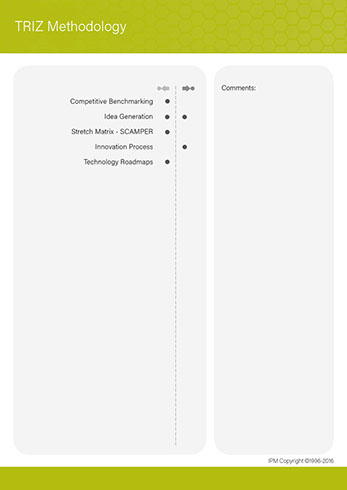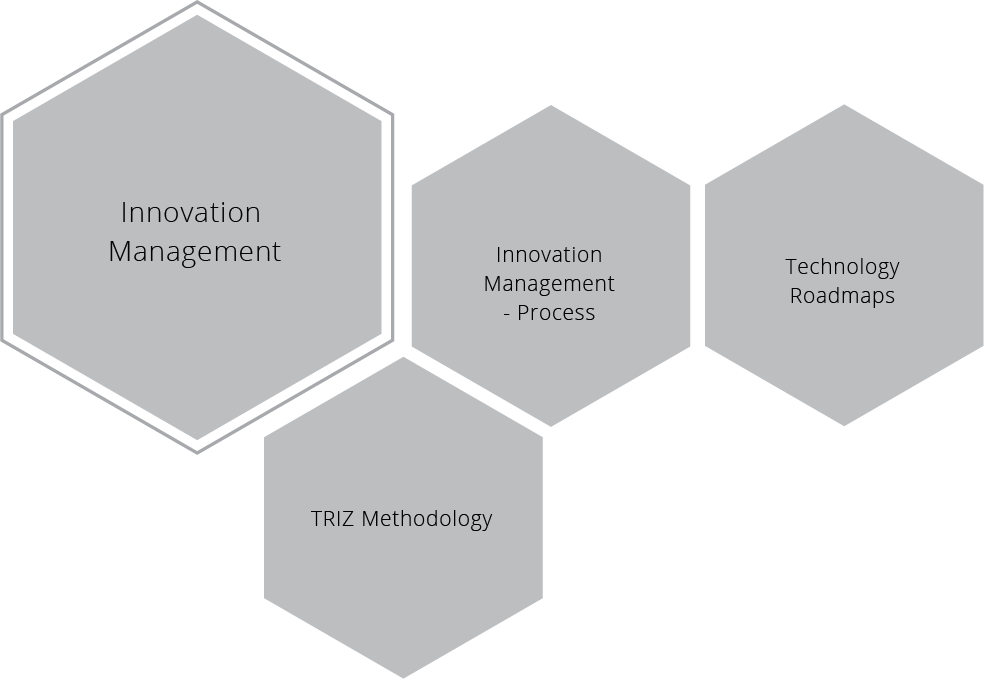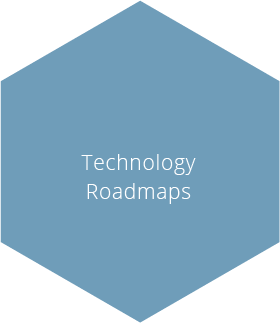Glossary
Logout
©Copyright Arcturus 2022, All Rights Reserved.
7
Terms & Conditions
|
|
|
|
Security & Privacy
Contact
TRIZ METHODOLOGY
|Introduction
TRIZ - The Theory of Inventive Problem solving...
'The theory of inventive problem solving is based upon extensive research into real inventions. The research focused on the most significant of those inventions - where the solution to the problem was not entirely obvious and required no trade-offs. The results of which revealed that inventors worldwide sub-consciously applied a common technique - TRIZ brings together these techniques and combines them with very practical methods.'
What is TRIZ?
TRIZ is the Russian acronym for 'Theory of Inventive Problem Solving'. It was developed by Genrich Altshuller the creator of Triz a patent investigator for the Russian Navy 1946. His research into innovation lead to a methodology which helps inventors find creative solutions to technical problems. Altshuller started his research by talking to psychologists to find the route of inventors creativity. He subsequently found that the investigations into behavioural science were not as productive as the insights gleaned from reviewing thousands of patents.
What is TRIZ Methodology?
Through his work as a patent investigator Altshuller identified patterns frequently used by in innovative patents. These patents provided solutions to contradictions and often represented a point along a repeatable line of evolution. TRIZ is a science that enables creativity to be approached systematically. Based on the analysis of tens of thousands of patents, in a classification of levels of inventions, or levels of inventive solutions (concepts), was proposed by Altshuller. There are eight laws of evolution and approximately 200 sub elements of more specific phenomenon occurring in the evolution of engineered systems.
The eight laws are:
• Emergence of a New System
• Increasing Ideality
• Uneven Development of Subsystems
• Dynamicity
• Transition to Bi and Poly Systems
• Harmonisation of Rhythms
• Transition to Micro levels and increased use of energy fields
• Increasing Levels of Automation
The above are principle elements of TRIZ and represent the core elements for innovation. Altshullers results have attracted professionals from many disciplines who have adopted and expanded his methodology. It is estimated that 1.7million patents worldwide have been reviewed to identify patterns and similarities have contributed to further enhancements of TRIZ.
Triz Toolkit...
• ARIZ (Algorithm for Inventive Problem Solving)
• SU-Field Analysis
• 76 Standard Solutions
• 40 Inventive Principles
• Separation Principles
• Compendium of Effects
• 8 Patterns of Evolution
• Selected examples of innovation
TRIZ is ideal for;
• Inventive Problem Solving
• Value Engineering
• Technology Forecasting
• Generation of Innovative Solutions.
• New Product Ideas.
• Product Marketing Strategy.
• Strategic Planning.
• Genuine Innovative products.
• Enhanced innovation skills throughout the product team.
• Reduced time to market.
• Clear Message - Improved Communications.
• Easy to understand - Strategy understood at all levels.
• Improved cross functional communications.
• Improved quality, safety and reliability.
|TRIZ in 40 steps…
You can use these steps however you like but we do suggest you start with the steps at the beginning. As you get used to using these triggers for inventing you will find that you can jump around happily and not get lost. But at first try it one step at a time and don’t skip too much! It is too easy to drive yourself to your end product idea without really testing out how innovative you can be.
The steps do work but they do need practise! So relax, have fun, try it a bit every day on simple things like better ways for washing up or shopping or planning a holiday or mending your shoes! Every day you solve problems. Here is our guide on how to make it easier and more fun to do so.
One warning – you may find yourself wanting to use these processes for helping others solve problems. But check first that they do want their problems solved. Sometimes people want to have a little moan so if they do, make them a cup of tea and listen!
The most important first step is to get ready to Dream. This is not about believing in the impossible. It is about being prepared to be open to seeing that what you now believe to be impossible may just be possible.
The future is open to an infinite number of possibilities. Infinity is a big number and we can think of the future as containing an infinite number of impossible and possible events. Rather than wasting time on working out what we think is impossible we can simply start with some dreams and see where these take us. It may seem like an endless list so don’t try to force it – just relax, draw, write some nonsense and see where it takes you.
A daydream is just a touch closer to reality. Take a dream and then walk yourself through it. What does it look like? What does it feel like? Well, use any sense you like!
Make notes about thoughts that come to mind – you will use these later when you start to focus on harder ideas.
Now you can explore your dream through other eyes. Go closer – imagine you are an ant, or a virus, or an atom! What does it look like now?
Then go further away. Now you are a tree, or an eagle or looking from a spacecraft or another planet. What does it look like now?
Imagine you are different – supposing you were 1 year old or 200 years old – how would your dream seem now?
Imagine you have four arms or just one. Imagine you move fast or slow, have strength or are weak. Explore all the changes in how you see the value of your dream as you explore it through other eyes. Again this will be useful later if you take some notes about your different views.
OK – now we are getting closer to something you might produce. There may be things around which deliver something. Think about things you don’t like about these things. Are they too complicated? Are they too expensive? Do they really work well? What are their faults? List them.
Most products and devices have all kinds of parts which don’t really deliver what you want but simply are there to outweigh some fault in the design. For example, an ideal table might be a table with no legs. The table top is what you want – the legs are there to keep it in place. A table top with no legs would be nearer to your ideal.
In TRIZ terms you are seeking to make clear what is Primary Functionality (it delivers what you want) and Secondary Functionality (it supports the way in which Primary Functions are delivered).
This may take some practise. Look at everyday things around you and list Primary and Secondary Functions. Another example: A window functions to separate the heat/substances of the inside and the outside. In hot countries the function is to keep out insects in cold countries it functions mainly to keep the heat in. How would you change the design to manage functions in these different places?
Free idea: To keep insects out you may have a wire grid. Could you design the wire grid so that it helped lose the heat from the house? Think of shape – to radiate heat or maybe to aid air flow!
Having worked through Primary and Secondary Functions now imagine that just one part delivers all the functionality and with no problems.
For example, an apple which does not bruise or collect dirt does not need wrapping. A wall which displays your TV picture means you do not need your TV.
You don’t have a clue as to how you might do this yet but go for amazing simplification. You might just find a way to do it!
Why is a question with many levels. I have a phone. At one level it functions as a way for me to speak to people. Why do I want to speak to people? If I want to send them information I can fax or Email or write. If I want to gauge how they respond to my message I like to hear their voice. Maybe I would like to see their face. Maybe I want to hear their heart rate or see it on a graph – especially if I am a doctor or maybe a salesperson!
Ask yourself why you want what you want. When you have the answer then ask yourself why you want that answer. What benefits does it bring? If you had had these benefits years ago what else would you have been able to do? If you had these benefits now what would changing what you do? Are there circumstances in which you would like other benefits, or more of those benefits. Keep asking why again and again and don’t be too easily pleased with your answers.
An example:
I buy birthday presents. I do this to please the person with the birthday. But I do not like trying to buy presents they might like because I always feel under pressure of time (I leave it too late). Why not not buy birthday presents? This could mean buying presents at any time without thinking of the person you might give it to. You see something that is nice so you buy it. You keep a stock of future presents. When birthdays arise you choose from your present stock. You can buy nice things when abroad, when browsing, any time.
You have a device. Think of how you would get on without the device. What would you do instead? Make notes!
So far you have probably only asked sensible questions so now ask some stupid ones. This helps bring to mind some key values which you may have overlooked. For example – what makes a car move? The engine, the fuel, the battery, the spark, the driver, the wheels…? How about the road? (Try imagining the car with the wheels not touching the road and you can see that the road is needed to make the car go forward, in current designs at least).
Why do we have a battery? Why do we have wheel nuts? Why do we have seats?
Or get really silly! Why do we drive at 1 to 100 m.p.h.? Why not drive at 0.00001 m.p.h.? Why not drive at 1347.9 m.p.h.? What comes to mind when you start asking ever more silly questions.?
Get a very very big sheet of paper. Get lots of post-it-notes. Write on the post-it-notes all the parts in great detail. Lay them out on the big sheet of paper and draw lines between parts that have some effect on each other. Make it really messy – you can clean it up later! Draw faces of how it feels to be a part in the system. Use colour, use very powerful words rather than soft words. E.g. don’t say this part wears this out – say this part grinds, devours, destroys, and disintegrates.
Move the post it notes around and ask what would happen if they did things in a different way to other parts. Keep on asking questions, including stupid questions. Explore the reality by making it unreal.
Now redraw it but on a small sheet and simply and in black on white! Finish the picture with “All I really need is…..?
Write a solution and see what Problems it might solve. Do this again and again. Keep asking what problems you have with these solutions.
Move your mind to another place. What problems exist that are essentially like this problem but very different. How would you create the solution for these analogous problems?
Nature is a rich resource of solutions. If you want to make a better door – what in nature is like a door? What is a door for a worm, or a bee, or a tree, or a virus? How are their doors made and how do they function?
Look closer and closer until you can draw the atoms. What do they do to each other? Are they friendly? Do they get along? Do they help each other? Are they the right shape? Do they fit together?
You are going on a picnic. You don’t want to take a cutting board for your sandwiches so you cut them before you go. (Prior Action). The bread will start drying out as soon as they are packed so you moisten them just a little before you pack them. (Cushion in Advance). For a big box of sandwiches which may squash the ones at the bottom you make little trays to sit in the sandwich box and these are the trays people eat off. (Equipotentiality and Universality)
Cool instead of heat, turn it over, do it back to front, make moveable what was unmoveable and vice versa.
This is a bit like Principles 8 and 9.
This is like vary the form but in three dimensions. (Principle 4, Asymmetry)
This is basically about making things move in harmony with the environment. This is why it is nice to have suspension on a pedal bike. You want the wheel to move dynamically in the vertical direction so it does not transmit bumps – it needs to be dynamic because sometimes you do want it to transmit the vertical force or it would not keep you off the ground.
So it is about how you make the working of an object respond dynamically to changes in the environment.
We don’t recommend this but sometimes you will choose to find away to get away with a bit less. A simple concept is to only put weed killer where there are weeds.
Think of bookshelf. Your books are of different heights but your shelves are of the same height. So you lay them flat to accommodate more books. It is just a question of saying to yourself what would it be like if I did in the other way? Another nice example is houses in Holland. They lean over. Instead of taking your furniture down the stairs and then out (which requires wide stairways), the furniture goes out (of the window) and then down!
Basically providing vibrations mechanically/acoustically provides energy. This will change how much energy may be needed to do a job – whether the job is to slide something along or to chemically change it (e.g. cooking).
Your device is doing something but it may not be best that it does it all the time in the same way. Manage its action for optimum effect.
The best example of this is washing the car. Change the water flow from a hose from constant flow to pulses.
Now think (at the level of the molecules) why this is better.
Remove any idle time from a system. For example, I could be getting this laptop to be printing while I am typing. It can do this in its spare time.
If you want to get past a pack of wild dogs it may be best to run!
Sometimes minimal harm occurs or minimal risk if you do things very quickly. The faster the better.
This even works for cutting. This is partly why an axe works well for chopping wood.
Use your cold to take time off work and do something useful like read a book!
Seriously, if there has to be a harmful effect then you can often use it to some benefit.
For example, you might alter your food so that when bad bacteria are growing on it, it changes colour and tells you!
And listen to it. An inventive engineer called Dorian Shainin said “Listen to the parts – they are smarter than the engineers”.
I solved gardening problem with this one. When mowing the lawn I plus the extension cable into the socket and feed the cable through the window. I cut the grass but then have grass all over my clothes and shoes when I come back into the house to take the plug out.
So I used a shorter cable from the socket to just outside the window and then plugged the longer extension into that. Cheaper than fixing up and outside supply which I use not very often.
This is basically about the fact that you don’t always need the expensive part to do all the work!
If I make a knife holder with a grinder built in then I will keep my knives sharp. Some substances are self-serving – for example aluminium oxidises on the surface in such a way as to prevent further oxidation. A good garden design will be self-serving, with some plants providing benefits against pests for others.
You can measure an image of an object easier than measuring the object or you can make a part of a device that wears cheap and easy to replace.
Use liquids and gases, optics and acoustics (Principles 28 and 29 –Replacement of a Mechanical System and Pneumatic or Hydraulic Construction)
The smaller the particles the finer the effect and if you choose carefully you can have more control.
This represents a general trend in design where solids are replaced by liquids then gases then fields and forces. For example, a mechanical gearbox is replaced by fluid drive.
Having flexibility allows us to manage the shape of an object for greater effect or may have protective properties that the main object does not have.
Having a porous object may make it lighter, the space in the voids may be filled with a useful substance.
By changing the colour of an object we can detect it more easily, measure it, and tell whether it is changing. You want to be able to see what it happening while fixing it together or you want to see what is happening while it is working. Use colour or maybe even infrared or ultra-violet! Make parts of different colours, take colour away.
Parts made of different materials can interact badly, wearing each other away, causing breakage.
Or you may match the material with the product it contains, moves, and manages in some way.
Maybe you could stir cold orange juice with an orange ice-lolly! It melts but what melts simply becomes more orange juice! Maybe you could cool orange juice and make orange ice sticks on a rod use also as a stirrer?
Maybe bottle tops could have a shape for undoing nuts! A simple use when they have finished their first task. Maybe they could be coin holders, or chess pieces or packing fillers? Think of how else you might use parts that would otherwise be discarded, or at the last resort, how do you make them easier to recycle – maybe they should recycle themselves as part of garden compost?
Think of the whole range of transformation of the whole device or parts. If it is very solid/rigid make it more flexible, or make it granular, or liquid or a gas. Any change you introduce which can mean that its properties can be changed by you for different functions at different times yields more opportunity.
Use heat, more of it or less, to change the phase of substances from gas to liquid or vice versa, from solid to gas etc.
The best option is always to get it to change naturally to suit the circumstances – one of Altshuller’s ideas in “And suddenly the inventor appeared” was to lower a heavy generator off a lorry and onto the ground by sliding it onto ice which then slowly melted to leave it sitting nicely in place. No heavy machines, just ice!
This is a technical bit, which may not be relevant for you, but you can think about how it applies even to non-technical situations.
The basic idea is that atoms and molecules exist in different states of ionisation. For oxygen you can just increase how much you have in the air, you can put in pure oxygen, you can ionise the oxygen, use ozone, or what is called singlet oxygen.
Underneath this idea is that the very small parts of the system can have different levels of energy. Change the enrage levels for small parts and you can manage their effect!
An example in a different field of business might be to consider a telephone answering service! Maybe you change the energy of your response from morning calls to those afternoon calls. Would high-energy responses fit customers better in the morning or the afternoon, or maybe just after lunch!
This is all about energy in the system at local levels. Think about what you want, when and where!
This is like the opposite of Principle 38! Take out any potentially damaging extra energy!
Nitrogen is an inert gas so you can use it to cover fires or prevent corrosion.
Or, as before, in a different kind of business, don’t have your customer complaints department in the middle of a railway station where there might be all kinds of randomly floating energy around that impacts on how the complainant
feels. Make it accessible but in a park, in a library, in people’s homes! (This if course depends upon what is going on in the home at the time).
This is all about mix and match. Add fibre, granules, and corrugations – in fact anything homogeneous (the same all over) can be varied.
One example of this could be the idea developing which is to have a bookshop also functioning as a coffee shop!
Your resources also include others! Don’t think about others as just being there for expert opinions. There are times when you need to ask a clown and times when you need to ask an expert. The time to ask an expert is when you really really know what you want!
If you ask an expert when your ideas are just forming you will be guided to all the known solutions that the expert feels comfortable with. That is, after all, why they are experts!
Always ask the clown first!
Even when you are really sure you know what you want and how you will put it together it can still be useful to challenge your ideas by changing your mind.
This will really test your commitment to your ideas. If they do not stand up to the change your mind test then maybe they should be dropped. If you have challenged them and they still come up with roses then you are highly likely to see your idea through to the end, no mater what obstacles are put in your way.
And the final test is how different would things be if you took away the rules that are governing your thinking or that of others. If a little bit of rule breaking really changed what you would do then maybe you start again when you have changed the rules.
Are your rules really that sacred? Many ancient and modern battles have been lost when someone broke the rules! Army generals plan their campaigns on beliefs about what their opponents will do – the opponents know this so they change the rules –and win!
Maybe your business idea is like that? Which side are you on?
Being an inventor will feel risky, it will take up your energy and can leave it dead on the floor.
Make sure you have some fun while doing all this thinking stuff! It isn’t abut only having fun – some hard work is needed but this is why the fun is also essential. And take time to relax!
Whatever goes on, you need to keep doing something! You started with some enrage to do something so however difficult it seems and however lost you feel keep up the momentum.
|The Dream
|Daydream
|Imagine
|Imagine the ideal device
|Jump in the deep end
|Ask Why
|The Ask why not
|Ask Stupid Questions
|Break down the problem
|See things in black and white
|Write a solution
|Use an analogy
|Somewhere the problem has already been solved
|Zoom in and Zoom out
|Ti esreveR (Principle 13 - Do it in Reverse
|Bend it Shape it, Curve it (Principle 14 - Spheroidality
|Make it dynamic (principle 15 - Dynamicity)
|Compromise (Principle 16 - Partial or Excessive Action)
|Try a new dimension (Principle 17 - Transition into a New Dimention
|Make it vibrate (Principle 18 - Mechanical Vibration)
|Manage the beat (Principle 19 - Periodic Action)
|Keep it going (Principle 20 - Continuity of Useful Action)
|Do it fast (Principle 21 - Rushing Through)
|Find a way to love the thorns (Principle 22 - Convert Harm into Benefit
|Get some feedback (principle 23 - Feedback)
|Use a Middleman (principle 24 - Mediator)
|Let it after itself (principle 25 - Self Service)
|Make a cheap copy (principle 26 and 27 - Copying and Dispose)
|Thin and Flexible (Principle 30 - Flexible Membranes or Thin Films)
|Make it Porous (Principle 31 - Porous Materials)
|Change the Colours (Principle 32 - Changing the colour)
|Make it Match (Principle 33 - Homogeneity)
|Discard or Re-use (Principle 34 - Rejection and Regenerating Parts)
|Metamorphosis (Principle 35 - Transformation of Properties)
|Take out the heat or put more in (Principles 36 and 37 - Phase Transition and Thermal Expansion)
|O, O2, 03 (Principle 38 - Accelerated Oxidation)
|Do it in space(Principle 39 - Inert Environment)
|Make it a composition (Principle 40 - Composite Materials)
|Ask a clown - or ask an expert
|Change your mind and try something absurb
|Slay a sacred cow, break some rules, break the mould
|Enjoy yourself
|Just do something
|Related Procedures
The following interrelationship maps indicate; suggested content from other models/processes which may have influence or an effect on the analysis of the title process. The left-hand column indicates information or impact from the named process and the left-hand column indicates on completion of the process/analysis it may have an influence or effect on the listed processes.
Note: A complete set (professional quality) of PMM interrelationship cards are available to purchase - please contact us for further details.

|Strategic Business Models, Workshop Tools & Professional Resources
The IPM practitioner series, is a definitive and integrated training programme for management professionals operating in the Product Management arena. So whether you’re the Managing Director, Product Director, Product Manager or a member of the Multidisciplinary Team we are confident that you will find this particular training series to be one of the best available and an invaluable asset to both you and your company.
PMM - Professional Support
Interactive Business Models
More












